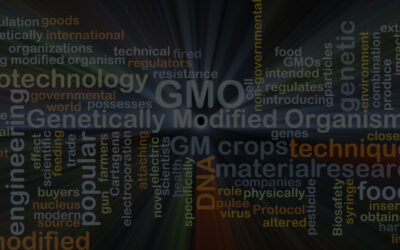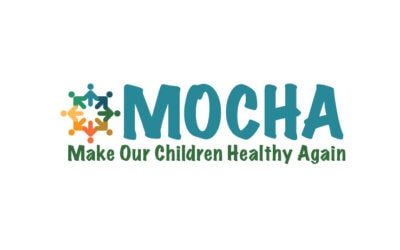GMOScience will be sharing with you our latest series on milks, from infant formulas to synthetic breast milk, genetically engineered milks, and raw milk.
Article 1 in the Got Real Milk Series
Why REAL Milk?
An internet search will reveal endless research and blogs on the pros and cons of the wide-range of available milks. Why has the milk market exploded? Why are there so many plant-based milks? Do we really need 50 infant formulas to choose from? The milk market is saturated with information and for parents, what was once a simple staple in every child’s diet has become a dietary conundrum.
As a pediatrician for over four decades, and investigator of genetic engineering for half as long, I hope to provide historical insight, digestible science-bites, and experience from caring for thousands of children, now offering the low down regarding milks. How did it get so complicated?
This article is the first in the series.
Infant Formula
The FDA has strict rules and regulations regarding infant formulas, production, and imports. The product manufacturing facility needs to be approved by the FDA prior to import. The majority of infant formula in the US consumed is made in the US, however, due to safety concerns, these trends may be changing.
The major US producers of infant formula are Abbott (Similac), Nestle (Gerber), Mead Johnson (Enfamil), and Perrigo (generic formulas). Presently, there are over 50 brands in the US, and various retailers have stepped into the market such as Costco (Kirkland) which may be produced by Perrigo. Amazon has also thrown their hat into the ring (Mama Bear), but they do not identify who is actually producing their formula. Many US moms are choosing European brands due to the concerns regarding toxic elements in the US preparations. The infant formula market is a confusing terrain matched by a tumultuous history. Let’s see if we can take a deeper dive into more about infant formula.
Formula Shortages
The infant formula market over the past few years has had some ups and downs. In 2022, there was an infant formula shortage, with some states experiencing crisis levels of supplies. Parents were warned not to attempt to make their own formulas. It is worth mentioning that preceding the introduction of commercialized formulas, parents did indeed make their own formulas and babies did well on specific recipe home-brews, however, it can be complicated and sterile-techniques are required.[1]
A Quick Look at History
Before the turn of the 20th century, women who were unable to breastfeed often engaged the services of a wet nurse to nourish their infants, a practice with historical roots dating back to over 2000 BC.[2] Notably, writings from the 17th century expressed apprehension regarding the potential transmission of “an imperfection” from the wet nurse to the child, along with concerns about a possible diminishment of the maternal-child bond. However, as bottle feeding and the utilization of animal milks gained prominence in the19th century, the prevalence of wet nurses gradually declined, leading to their near-extinction by 1900.
Animal Milks for Human Babies
Dating back to 2000 BC, animal milks sources have been offered for infant feeding. Marketing artificial milks has impacted breastfeeding trends, but breast milk is still the best source of infant nutrition. The use of donkeys, pigs, camels, and horses have been utilized, depending on which animals were available, however, the most common milk used for alternative feeding was cow’s milk.
As sterilization, refrigeration, and vitamin fortification became the norm, infant formulas improved in their safety and quality. Consequently, breastfeeding declined globally until the 1970s, and has since made a modest recovery. Compared to the 20th century, only half as many infants are breastfed presently, now reaching approximately 42%. There is no doubt that increasing rates of childhood disorders such as asthma/eczema/allergies (atopic diseases), obesity, and diabetes mellitus are linked to formula feeding.[3]
Pieces of the Puzzle – Are Infant Formulas Safe?
Due to improved sanitation, the microbial contamination of infant formulas has been largely eliminated, however, there are still occasional outbreaks such as the one causing the infant formula shortage in 2022 noted above with Cronobacter sakazakii.[4] Other harmful contaminants have been reported such as with the toxic chemical melamine. In 2008, melamine-contaminated formula occurred in China causing kidney injury and death. Melamine is a triazine compound used in the formulation of melamine formaldehyde resin for the manufacture of laminates and dish ware, and was added to foods to increase their protein content.[5]
Melamine traces were also found in US infant formulas as reported by the NY Times in 2008.[6] However, the FDA insisted that there was no concern because of the low levels encountered. The FDA does allow levels of melamine below 250 ppb (parts per billion) in infant formula. Guidelines and allowances are varied depending on the agency and the different metals. While there are extensive standards for other contaminants such as the toxic heavy metal lead, there are even fewer standards for toxic mercury. Two graphs are provided below:[7]
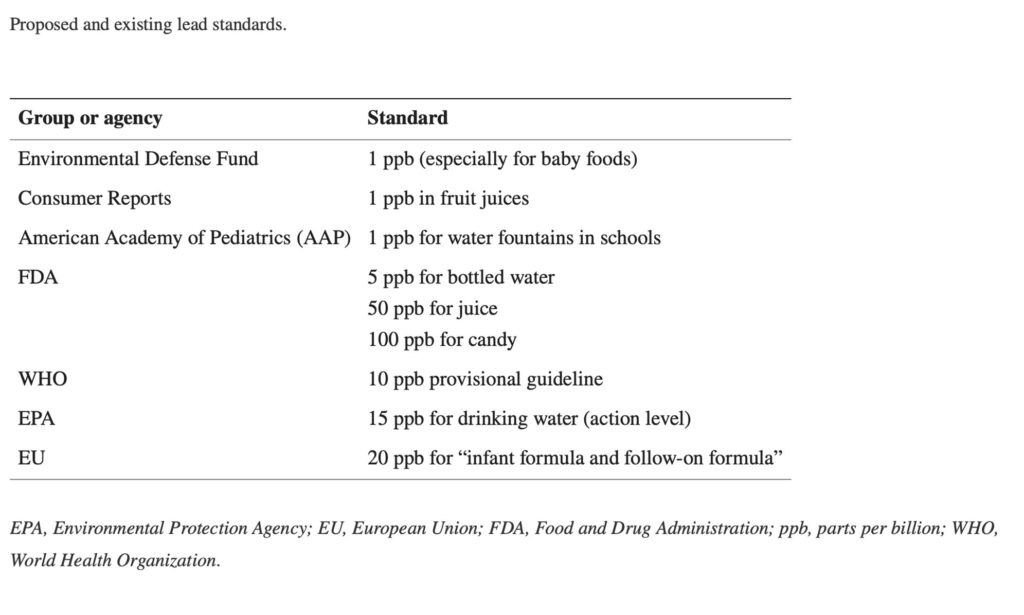
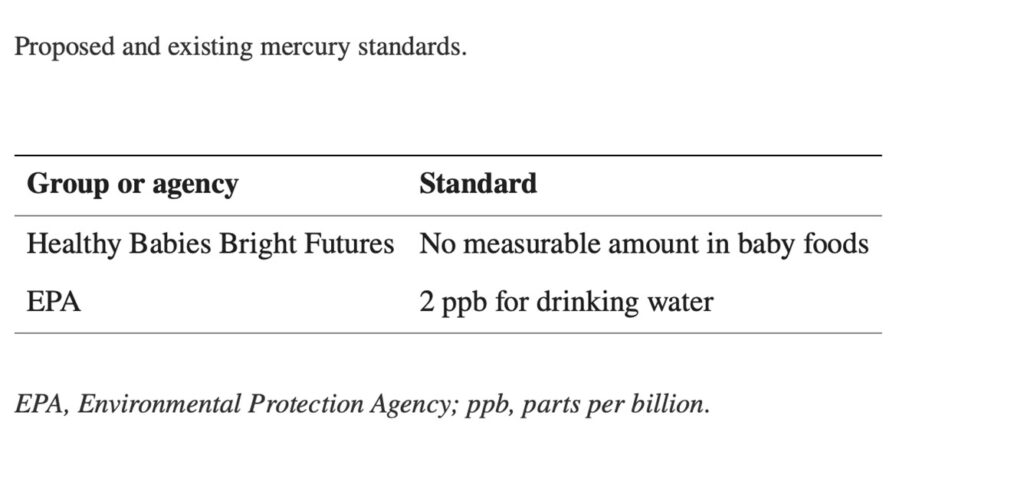
The paradigm of “dose makes the poison” is antiquated, as emerging evidence shows that even low levels of toxic elements pose significant risks, particularly for infants. Infants are particularly vulnerable to the adverse effects of toxic metals due to their small size, rapid growth, immature detoxification pathways, and developing organ systems. Even low levels of exposure to metals such as lead, arsenic, mercury, aluminum, and cadmium can have detrimental effects on infants’ neurological development, growth, and overall health. These metals can accumulate in the body over time and may lead to long-term health consequences.
More Toxic Than Melamine?
As previously highlighted, extensive media attention was directed towards bacterial contamination in infant formula in 2022. However, an equally pressing concern, often overlooked in media coverage, pertains to the presence of heavy metals in infant formula. While heavy metal contamination has garnered significant scrutiny in the context of baby food, comparatively less emphasis has been placed on its presence in infant formulas.
This raises the question: Should this issue be a cause for concern?
What Are Heavy Metals and Why Are They Toxic to Children?
Not all metals are toxic. Some metals, such as sodium, potassium, magnesium, and calcium are essential nutrients, required for biologic function. However, even beneficial metals, such as zinc, copper, iron, and manganese can cause adverse health effects when their levels are out of balance or too high.
The term “heavy metal” refers to the density or weight of the metal and they are generally toxic to living organisms. This group comprises metals such as mercury, cadmium, lead, and arsenic (which is a metalloid; a mixture of metals and nonmetals). Aluminum is a toxic metal, although it does not meet the heavy metal terminology requirement which is based on weight. Every biologic system can be effected by exposure to these compounds through different pathways causing damage to cells (oxidative stress) and destruction of different compounds in the body including DNA which means it has the ability to be carcinogenic. Mixtures of these metals with other toxic elements (termed “xenobiotics”) can have a cumulative toxicity. The most common way of poisoning from heavy metals is the daily consumption of contaminated food which includes…Infant formula
How this contamination occurs is shown in the graphic below:[8]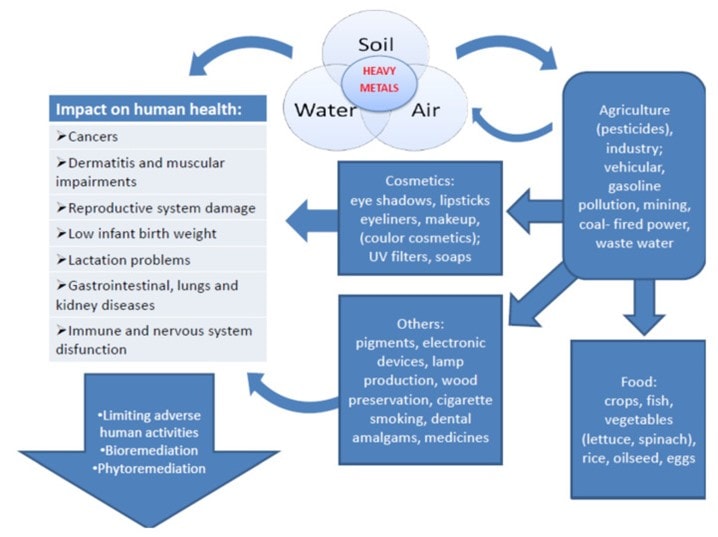
“Acceptable levels” of heavy metals have been set by the World Health Organization (WHO) from ppt (parts per trillion) to ppm (parts per million). However, the truth is there are no safe levels of heavy metals for our children. What may not be widely known is that bioremediation is achievable and can remove the heavy metals from the environment.
A Few Words About Bioremediation
Bioremediation involves using living organisms to remove or neutralize contaminants from soil. Several methods of bioremediation can effectively remove heavy metals from soil:
- Phytoremediation: This method utilizes plants to absorb and accumulate heavy metals from soil. Certain plants, known as hyperaccumulators, have the ability to accumulate high concentrations of metals in their tissues. Once the plants have absorbed the metals, they can be harvested and disposed of, effectively removing the contaminants from the soil.
- Microbial remediation: Certain microorganisms, such as bacteria and fungi, have the ability to metabolize or bind heavy metals in soil. This process can involve microbial-mediated precipitation, where microorganisms convert soluble metals into insoluble forms, reducing their mobility and bioavailability in the soil.
- Bioaugmentation: In this method, specific microorganisms or enzymes are introduced into the contaminated soil to enhance the bioremediation process. These added organisms can enhance the natural abilities of soil microbes to degrade or immobilize heavy metals.
- Composting: This process involves the decomposition of organic matter, such as plant material or manure, under controlled conditions which can help immobilize heavy metals by binding them to organic matter, reducing their availability for uptake by plants or leaching into groundwater.
- Phytostabilization: Planting vegetation to immobilize heavy metals in the soil, prevents their migration to surrounding areas or uptake by plants. The roots of the plants help bind the metals in place, reducing their mobility and bioavailability.
These bioremediation methods offer sustainable and cost-effective approaches to remediate heavy metal-contaminated soil, providing environmentally friendly alternatives to traditional remediation techniques.[9]
Let’s dispel the notion that heavy metal contamination of our soil and the contamination of resultant products cannot be eradicated.
What About Heavy Metals in Infant Formula?
There has been much written about toxic metals in baby food and this awareness although imperative, has not led to legislative changes.[10] There is much less awareness, testing, and consistency reporting on infant formulas in regard to heavy metals.
A Turkish study from 2022 showed that infant formula contained variable levels of lead, cadmium, arsenic, and mercury.[11] The formula brands nor the health status of the infants were identified.
In a Lebanese study from 2021, levels of lead, cadmium, and arsenic were found in as high as 59% of the 39 infant formula brands test, and at higher concentrations compared to breast milk.[12] The brands were imported from 8 countries and from multiple manufacturers, although they were not identified.
Research on this topic was also reported in 2009, showing that aluminum, cadmium, and lead were detected in different brand infant formulas using other lab techniques (electrothermal absorption spectrometer).[13]
Mommyhood 101 independently conducted a study to test for 4 different heavy metals in 13 infant formulas.[14] They found the following:
- All tested baby formulas contained detectable levels of arsenic, cadmium, lead, and/or mercury.
- 12 of the 13 formulas exceed the AAP and EDF limit of 1 ppb of lead.
- 6 of the 13 formulas exceeded the CR limit of 1 ppb of cadmium.
- None of the formulas exceeded the HBBF limit of 25 ppb of arsenic.
- Lower levels of mercury were found than in a can of tuna fish, but the number was not reported.
- Overall, organic baby formulas showed lower levels of heavy metals.
The FDA Total Diet Study
In July 2022, the FDA published their Total Diet Study (TDS), a program launched in 1962, reporting on the years from 2018-2020.[15] Initially, the program was designed to monitor for the radioactive contamination of foods. Since the initiation of this ongoing research, the study presently monitors levels of nutrients (i.e., calcium), and contaminants (i.e., lead, pesticides, and other toxic chemicals) consumed by people in the US.[16] Nine hundred and ten substances were tested for biologic minerals and 5 heavy metals including arsenic, cadmium, lead, mercury, and uranium.
My analysis conducted on 910 substances reported in the study pertaining to infant formula revealed findings from four samples:
- Sample #734, representing an unidentified brand of milk-based, powdered infant formula prepared with water, exhibited no presence of heavy metals.
- Similarly, Sample #735, representing a soy-based, powdered infant formula prepared with water, also displayed no detectable heavy metals.
- However, Sample #767, attributed to another unidentified brand of milk-based powdered formula without added water, indicated the presence of arsenic, cadmium, lead, and uranium.
- Likewise, Sample #768, representing an unidentified soy-based powdered infant formula without added water, demonstrated the presence of arsenic, cadmium, and uranium.
Two out of the four formulas subjected to testing by the FDA yielded concerning results, showing the presence of toxic metals and even radioactive uranium. Despite these alarming findings, no discernible actions were taken by the FDA in response to this critical issue. The EPA, under the auspices of the Toxic Substances Control Act (TSCA) passed in 1976, was vested with the authority to mandate reporting, record-keeping, testing requirements, and restrictions pertaining to chemical substances and mixtures.[17] While certain substances are typically exempt from TSCA oversight, such as food, drugs, cosmetics, and pesticides, heavy metals fall within its purview.
In light of the EPAs regulatory framework, infant formulas found to contain heavy metals, as identified by the FDA, must be subject to prohibition due to their evident and unreasonable risk to public health.
Children, and particularly infants, are at an extreme risk from the toxicity from heavy metals even more so than adults. The heavy metals’ harmful effects include neurocognitive and behavioral disorders, respiratory issues, cardiovascular disease, and cancer.[18]
GMOScience Takes Action
It is imperative that we collectively recognize the fundamental necessity of providing our babies with non-toxic nutrition as an absolute imperative, not merely a suggested guideline. The revelation of heavy metals contaminating infant formula is deeply troubling, but what is truly unacceptable is the lack of accountability: No products or companies have been named, no corrective measures implemented, no public health advisories issued, and no legislative actions initiated.
This status quo cannot persist.
As highlighted in our recent article “HACKED!”, GMOScience, in collaboration with Moms Across America and The New MDS, has mobilized resources through your generous contributions to conduct independent studies on infant formulas. Our goal is to meticulously identify and quantify the presence of heavy metals, including aluminum, arsenic, cadmium, lead, and mercury.
We extend our heartfelt gratitude for your unwavering support of our endeavors, which are dedicated to safeguarding the well-being of all our children. Stay tuned as we work to unveil our research findings and advocate for tangible solutions to this urgent issue. Together, we can enact meaningful change and ensure a safer, healthier future for the next generation. Partner with us: Contact info@gmoscience.org.
[1] https://www.westonaprice.org/health-topics/formula-homemade-baby-formula/#gsc.tab=0
[2] https://www.ncbi.nlm.nih.gov/pmc/articles/PMC2684040
[3] https://www.sciencedaily.com/releases/2013/06/130605133710.htm
[4] https://www.cdc.gov/cronobacter/outbreaks/infant-formula.html
[5] https://www.sciencedirect.com/science/article/abs/pii/S2214799319300281
[6] https://www.nytimes.com/2008/11/26/us/26formula.html
[7] https://www.ncbi.nlm.nih.gov/pmc/articles/PMC9271943/
[8] https://www.ncbi.nlm.nih.gov/pmc/articles/PMC8511997/
9] https://www.ncbi.nlm.nih.gov/pmc/articles/PMC8511997/#B145-molecules-26-06060
[10] https://www.consumerreports.org/babies-kids/baby-food/are-heavy-metal-levels-in-baby-foods-getting-better-a1163977621/
[11] https://www.sciencedirect.com/science/article/abs/pii/S0889157521004580
[12] https://www.sciencedirect.com/science/article/abs/pii/S0956713520306666
[13]> https://www.sciencedirect.com/science/article/abs/pii/S027869150900132X
[14] https://mommyhood101.com/nontoxic-baby-foods-and-formulas
[15] https://www.fda.gov/media/159751/download?attachment
[16] https://www.fda.gov/food/reference-databases-and-monitoring-programs-food/fda-total-diet-study-tds
[17] https://www.epa.gov/laws-regulations/summary-toxic-substances-control-act
[18] https://pubmed.ncbi.nlm.nih.gov/30941546/

